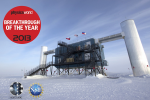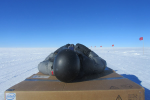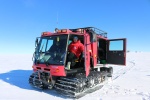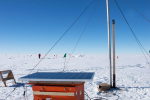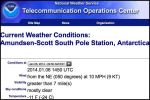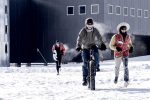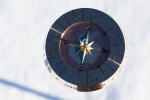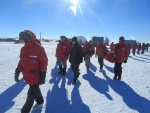There are
“IceCube”
902
Friday, December 13, 2013 - 4:30pm
The IceCube project has been awarded the 2013 Breakthrough of the Year by the British magazine Physics World. The Antarctic observatory has been selected for making the first observation of cosmic neutrinos, but also for overcoming the many challenges of creating and operating a colossal detector deep under the ice at the South Pole.
Article
Friday, December 13, 2013 - 11:15am
It looks like IceCube winterover Ian Rees is practicing a good luge position, but he’s just taking advantage of his perch to capture photos.
Article
Monday, December 23, 2013 - 10:30am
It was a week filled with movement outdoors.
Article
Thursday, April 23, 2015 - 12:30pm
The South Pole is home to ice, wind, and science. One South Pole physics project, the Askaryan Radio Array (ARA), is making the most of the conditions by outfitting their detector with wind turbines and solar panels to help power their stations. To save energy and funds, these remote power systems are being installed and tested.
Article
Tuesday, April 17, 2012 - 12:30pm
Although cosmic rays were discovered 100 years ago, their origin remains one of the most enduring mysteries in physics. Now, the IceCube Neutrino Observatory, a massive detector in Antarctica, is honing in on how the highest energy cosmic rays are produced.
"Although we have not discovered where cosmic rays come from, we have taken a major step towards ruling out one of the leading predictions," said IceCube principal investigator and University of Wisconsin - Madison physics professor Francis Halzen.
Article
Wednesday, April 18, 2012 - 12:00pm
In 1912, Austrian physicist Victor Hess was using balloons to measure radiation levels in the Earth’s atmosphere. His innovative and meticulous work required him to travel with the balloon up to altitudes of 5.3 km, monitoring the measuring equipment and checking data.
The danger of traveling to such heights paid off for Hess. Unexpectedly, he found higher levels of radiation as the balloon rose and concluded that radiation was penetrating the atmosphere from outer space.
Article
Tuesday, January 7, 2014 - 2:15pm
The polar vortex that has enveloped the Midwest has created an interesting scenario: temperatures in Wisconsin have dipped below those at the South Pole in Antarctica. At the South Pole, summer temperatures are often around -25 degrees Fahrenheit.
Article
Thursday, January 9, 2014 - 1:15pm
The Race Around the World, an approximately two-mile course at the South Pole, is one that some folks take seriously, with planning and preparations aimed at bringing them across the finish line first.
Article
Thursday, January 16, 2014 - 2:45pm
Out with the old, in with the new.
Article
Thursday, January 23, 2014 - 12:30pm
What’s new at the Pole? Well, some new people are there—it’s still summer, so groups of people are still coming and going.
Article

